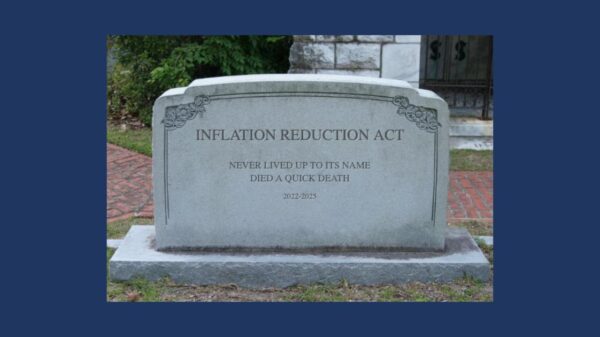President Joe Biden, fresh from a surprisingly good November election for his fellow Democrats, has redoubled his commitment to rid the world of natural fuels (oil, gas, coal) and impose an all-electric universe powered in large part by offshore wind farms.
To that end, Biden recently announced massive wind lease areas offshore from Lake Charles, Louisiana, and Galveston, Texas. One is a 188,023-acre tract located 56 miles offshore from Lake Charles; the other is a 508,265-acre tract 24 nautical miles offshore from Galveston. While Louisiana’s Democrat Governor John Bel Edwards is ebullient about the economic prospects for offshore wind, his Texas counterparts are not.
Two years ago, at the inaugural meeting of his Climate Initiatives Task Force, Edwards had announced a major collaboration with the Bureau of Ocean Energy Management (BOEM) to establish a task force to build a blueprint for renewable energy production in the Gulf of Mexico.
Edwards was buoyed by the observation from Office of Coastal Activities Deputy Director Harry Vorhoff that “Renewable energy like offshore wind can help the state cut its emissions and do its part in avoiding the worst impacts of climate change.” As the new leases were announced, Edwards boasted that Louisiana lift-boat operators helped develop the nation’s first commercial offshore wind farm in Rhode Island. That experience, he mused, bodes well for Louisiana.
The National Renewable Energy Laboratory claimed that a single 600-megawatt offshore wind farm would generate 4,400 jobs and $445 million in economic output just during the construction phase – and 150 permanent jobs. Louisiana’s Economic Development Secretary Don Pierson noted that some offshore oil and gas service providers had already played key roles in early development of East Coast offshore wind projects.
GNO Inc. CEO Michael Hecht agreed that “offshore wind is an exciting and multifaceted opportunity for Louisiana,” and that “wind is a natural extension of Louisiana’s energy industry and employs many of its existing sectors like offshore marine services…. With the world’s largest wind turbine blades already under development in New Orleans … wind will help support Louisiana’s growing reputation as a leader in environmental management.”
By contrast, Galveston (TX) state Representative Mayes Middleton responded to the BOEM announcement with a letter warning that offshore wind could be a net negative for Texas. Middleton highlighted renewable energy’s unreliability, noting the failure of onshore wind farms that froze up during the February 2021 winter storm.
In the letter, Middleton asserted that, “There are grave concerns about the serious harm that the proposed leases could have on the commercial and residential fishing industry, the maritime economy, the human environment, and Texas’ economic prosperity that need to be resolved before any lease should even be considered.”
But Middleton’s heaviest hammer was his assertion that the BOEM likely violated federal law by not preparing an environmental impact statement to inform residents of how the proposed development might affect other operations near the Galveston coast, notably commercial and residential fishing. He also suggested offshore wind could impact shipping lanes and cost the Port of Houston $802 billion every year – a huge net loss.
By approving offshore wind leases that would almost certainly result in the abandonment of the entire lease area by commercial fishermen “due to difficulties with navigation,” Middleton contended that the BOEM’s leases “would violate the Outer Continental Shelf Land Act, severely harm America’s food supply, decrease shoreside businesses’ profits, and make the U.S. more reliant on imported seafood from Asia.”
Even the East Coast wind farms that Edwards praised are having serious problems, according to recent reports. On Halloween, New Jersey utility Public Service Enterprise Group Inc. announced it was considering withdrawing from Ocean Wind 1, a proposed project in the Atlantic Ocean. Two weeks New England utility Avangrid Inc. said its Commonwealth Wind project was no longer viable due to higher costs and supply chain issues.
Bidenflation, rising interest rates, and worldwide supply chain failures are threatening the offshore wind bubble off the East Coast. This should be no surprise, according to Jason Isaac, Director of Life:Powered, a national initiative of Texas Public Policy Foundation. Isaac chides “the liberal wing” for its “deafening” silence on offshore wind’s “threat to our country’s precious natural beauty.”
Commenting on a lawsuit filed by TPPF on behalf of New England fisheries, Isaac in July had asked, “Who benefits” from these projects – and his answer was “foreign corporations investing in the project who will reap the windfall of American taxpayer-funded subsidies.”
TPPF General Counsel Robert Henneke explained that, “In the Vineyard Wind project, the federal government ignored multiple legal protections for affected stakeholders,” yet its own report admitted that “the turbines would force the fishing industry to abandon a 75,614-acre area because the boats can’t navigate around the massive foundations holding up the windmills.”
Just this month, the Texas-based Institute for Energy Research tallied up various problems with East Coast and European offshore wind farm developers. According to IER, “inflation, slow permitting, and uncertainty around the European Union’s emergency electricity market interventions are currently delaying or stalling orders for new wind turbines.” During the last quarter, the only orders for new wind turbines in EU countries were for onshore turbines.
The IER report concludes that expensive offshore wind farms are suffering from rising interest rates, inflation, and supply chain bottlenecks. For American consumers, IER recommends that the U.S. would be best to follow in Europe’s current footsteps of no offshore wind turbine orders and a significant slow-down in onshore wind turbine orders, as their intermittency means expensive backup power is needed, which is not included in the cost estimates.
Despite all these negatives, the Biden Administration is hellbent on destroying the oil and gas and coal industries and has done little to jumpstart a revival of nuclear energy in the U.S. The results, if his plans are not thwarted, will be higher energy prices, increasing blackouts and brownouts, and quite likely economic disaster.
The key to continuing the Biden policies, explains TPPF’s Brent Bennett, is the huge federal subsidies for wind and solar that distort markets and expand the penetration of intermittent, and therefore unreliable, energy at the same time federal policies are raising the cost of conventional energy products. The target price for offshore wind is twice the average wholesale price that Texans pay today – higher than any benefit from subsidies.
Curiously, a recent Bloomberg article revealing that Vesta, the world’s largest builder of wind turbines, will have a “negative 5 percent profit margin in 2022” (despite raising prices by 30 percent in the past year) reveals the likely biggest reason that many Americans, Europeans, and others still support expansion of wind and solar.
Bloomberg surmised that, “Renewable power’s big mistake was to promise to always get cheaper.” Vesta now fears that too many believe “that energy and electricity should become free.” But, as the old proverb says, “There is no such thing as a free lunch.”
Or, as we should have learned from the 1994 Winona Ryder film, “Reality Bites!”
Duggan Flanakin is a policy analyst and journalist based in Austin, Texas. This article was originally published by RealClearEnergy and made available via RealClearWire.





















